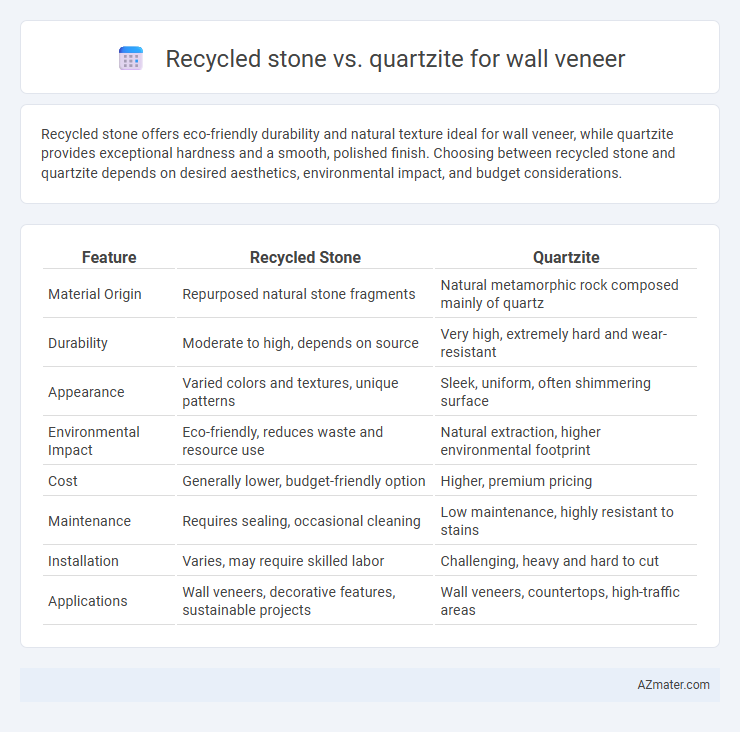Recycled stone offers eco-friendly durability and natural texture ideal for wall veneer, while quartzite provides exceptional hardness and a smooth, polished finish. Choosing between recycled stone and quartzite depends on desired aesthetics, environmental impact, and budget considerations.
Table of Comparison
| Feature | Recycled Stone | Quartzite |
|---|---|---|
| Material Origin | Repurposed natural stone fragments | Natural metamorphic rock composed mainly of quartz |
| Durability | Moderate to high, depends on source | Very high, extremely hard and wear-resistant |
| Appearance | Varied colors and textures, unique patterns | Sleek, uniform, often shimmering surface |
| Environmental Impact | Eco-friendly, reduces waste and resource use | Natural extraction, higher environmental footprint |
| Cost | Generally lower, budget-friendly option | Higher, premium pricing |
| Maintenance | Requires sealing, occasional cleaning | Low maintenance, highly resistant to stains |
| Installation | Varies, may require skilled labor | Challenging, heavy and hard to cut |
| Applications | Wall veneers, decorative features, sustainable projects | Wall veneers, countertops, high-traffic areas |
Introduction: Recycled Stone vs Quartzite for Wall Veneer
Recycled stone wall veneer offers an eco-friendly and cost-effective alternative by repurposing natural stone materials, reducing waste and environmental impact. Quartzite, a natural metamorphic rock known for its hardness and durability, provides a sleek, high-end finish with excellent resistance to weathering and wear. Comparing recycled stone and quartzite for wall veneer involves balancing sustainability and budget against longevity, aesthetic appeal, and maintenance requirements.
Material Composition and Origin
Recycled stone wall veneer is composed of repurposed natural and manufactured stone materials, often sourced from construction debris or reclaimed stone, promoting sustainability by reducing landfill waste. Quartzite wall veneer originates from natural quartz-rich sandstone subjected to intense heat and pressure, resulting in a dense, durable metamorphic rock with high silica content. The recycled stone offers diverse textures and colors derived from its varied origins, while quartzite provides consistent hardness and a natural crystalline appearance due to its geological formation.
Environmental Impact and Sustainability
Recycled stone wall veneer significantly reduces environmental impact by reusing existing materials, minimizing quarrying and landfill waste while conserving natural resources. Quartzite, a natural stone, requires extensive mining and processing, leading to higher carbon emissions and habitat disruption. Choosing recycled stone supports sustainable construction practices by promoting circular economy principles and lowering the overall ecological footprint.
Durability and Longevity
Recycled stone offers impressive durability for wall veneer, resisting weathering and decay due to its naturally dense composition. Quartzite exhibits exceptional hardness and scratch resistance, making it highly durable and capable of withstanding harsh environmental conditions over time. Both materials provide long-lasting performance, but quartzite generally outperforms recycled stone in terms of sustained resistance to erosion and color retention.
Aesthetic Appeal and Design Options
Recycled stone offers a unique, rustic aesthetic with natural color variations and irregular textures, enhancing wall veneers with an eco-friendly charm. Quartzite provides a sleek, modern look with consistent patterns and a polished finish, ideal for contemporary and upscale designs. Both materials deliver durability, but quartzite's refined surface allows for more versatile design options in sophisticated interiors.
Installation Process and Costs
Recycled stone wall veneer requires less intensive cutting and shaping, making installation faster and generally less labor-intensive compared to quartzite, which demands precise cutting due to its hardness and natural variability. The cost of recycled stone is typically lower both in terms of material and labor, while quartzite, known for its durability and aesthetic appeal, commands higher prices due to specialized tools and skilled labor required for proper installation. Choosing between recycled stone and quartzite hinges on budget constraints and desired installation complexity.
Maintenance Requirements
Recycled stone wall veneer requires minimal maintenance, as it naturally resists stains and weathering due to its composite material composition. Quartzite wall veneer demands regular sealing to prevent moisture penetration and staining, maintaining its durability and appearance over time. Both options benefit from periodic cleaning, but recycled stone often offers greater long-term ease of care.
Performance in Indoor vs Outdoor Applications
Recycled stone offers excellent sustainability and a unique aesthetic but tends to be less durable and more porous than quartzite, making it better suited for indoor wall veneer applications where exposure to extreme weather is limited. Quartzite exhibits superior hardness, abrasion resistance, and weather resistance, which ensures long-lasting performance and minimal maintenance in outdoor environments. For outdoor wall veneers, quartzite's natural ability to withstand freeze-thaw cycles and UV exposure makes it the preferred choice over recycled stone.
Cost Comparison: Upfront and Long-Term
Recycled stone veneer generally offers a lower upfront cost compared to quartzite, making it an attractive option for budget-conscious wall applications. Quartzite, while more expensive initially due to its natural durability and aesthetic appeal, tends to require less maintenance and has a longer lifespan, potentially reducing long-term expenses. Evaluating both materials involves balancing immediate budget constraints against anticipated durability and upkeep costs to determine the most cost-effective solution for wall veneer projects.
Choosing the Best Option for Your Project
Recycled stone offers an eco-friendly, cost-effective solution for wall veneer, providing unique textures and a rustic aesthetic perfect for sustainable design projects. Quartzite, known for its durability and natural resistance to weathering, is ideal for high-impact areas demanding long-lasting performance and a sleek, polished finish. Evaluating your project's environmental goals, budget, and desired visual impact will help determine whether recycled stone's sustainability or quartzite's strength better fits your specific needs.

Infographic: Recycled stone vs Quartzite for Wall veneer
 azmater.com
azmater.com